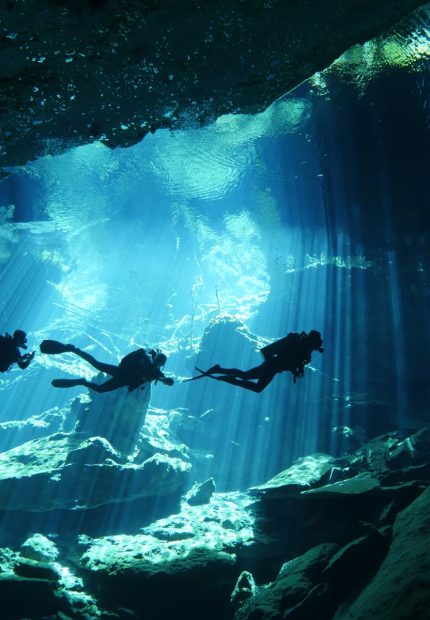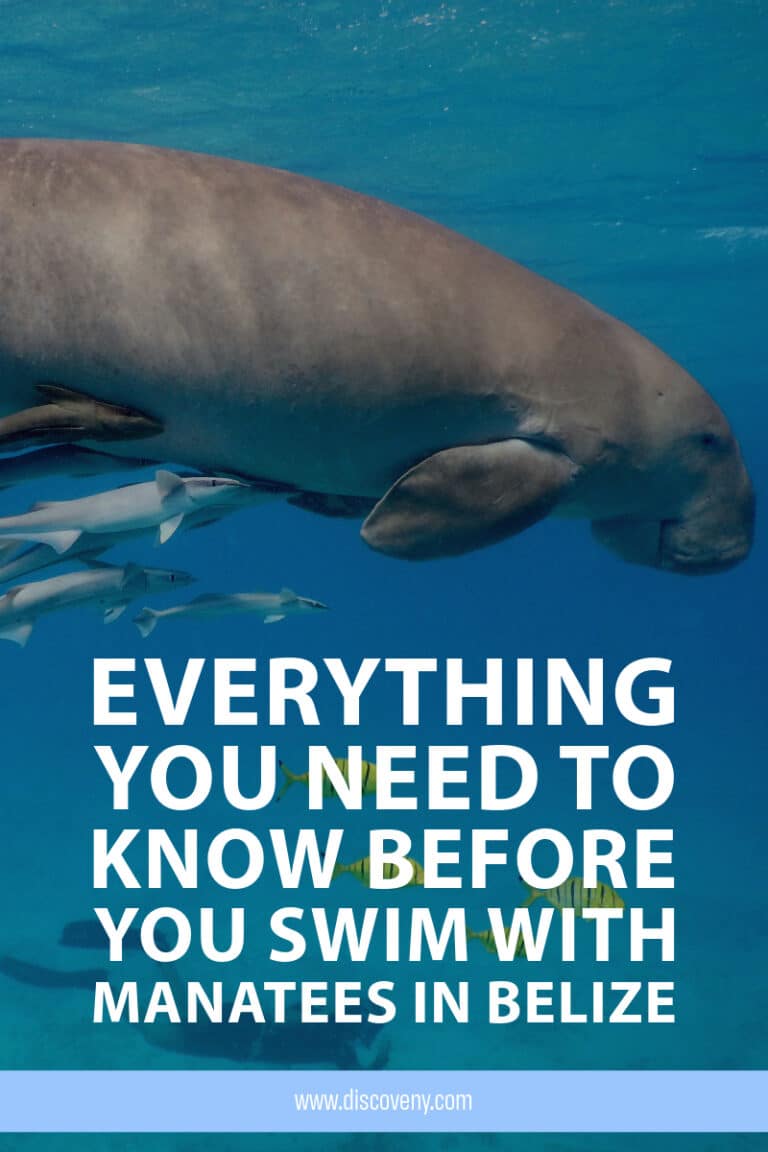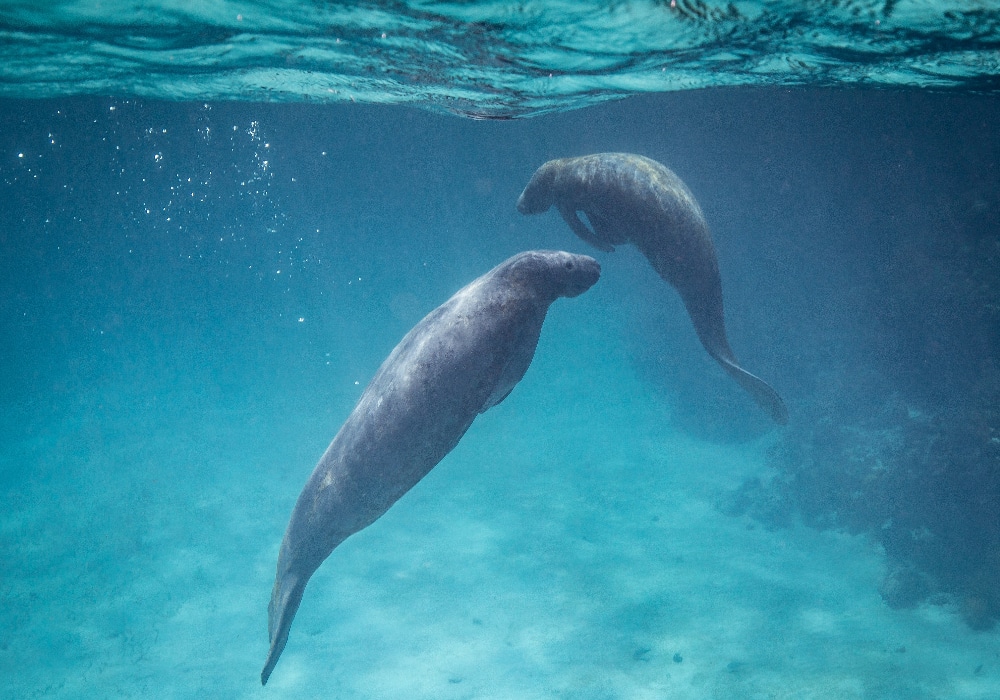
Swim with manatees in Belize: Everything you need to know before you go [2024]
Central America has so much to do and see, but one of the most incredible wildlife encounters we had on our backpacking adventure was being able to swim with manatees in Belize. If you are travelling to Belize, a snorkelling tour in Caye Caulker should definitely be on your itinerary. There is nothing cuter than floating alongside these chill little sea-blobs and watching them graze on sea grass and nuzzle each other!
We found it hard to find any information on how to swim with manatees in Belize. There are a couple of blog posts out there, but none of them also answered our burning question: is swimming with manatees in Belize ethical and responsible wildlife tourism? This guide will explain everything you need to know about booking a tour, guidelines for swimming with manatees, and how to make sure you have an ethical and responsible wildlife encounter.
Jump to:
- What are Manatees
- Why swim with manatees in Belize?
- Manatee Conservation Challenges in Belize
- Where can you see manatees in Belize?
- Is swimming with manatees ethical?
- What to expect on a Caye Caulker snorkel tour?
- Is snorkelling with manatees dangerous?
- How to book a manatee snorkelling tour
- Rules to follow when you swim with manatees in Belize
- What to pack when you swim with manatees in Belize?
- Other amazing things to do in Caye Caulker
WHAT ARE MANATEES?
Manatees are large, herbivorous marine mammals. They’re some of the ocean’s gentle giants, rocking a robust blob-like body, paddle-shaped tails, and a chill attitude. Manatees usually have grey or brown skin, and little whiskers to help them find food. They’re often also called sea cows, because they’re chunky, slow-moving, and eat plants.
Like us, manatees prefer to hang out the warmer oceans of the planet’s tropical and warm-temperate areas. You can find manatees in warm, shallow coastal waters, estuaries, and rivers from Florida to Brazil, and around West Africa too.
Fun fact: Like us, these sweet and slow-moving mammals also like to eat! A manatee can consume from 4 to 9 per cent of its body weight in aquatic plants and sea grass every day!
There are three different species of Manatee, but in Belize, it’s the West Indian manatee that steals the show. Belize is an important habitat for West Indian manatees and they can be found floating around in mangroves, lagoons, rivers, and the ocean looking for seagrass and other plants.
Although they’re sociable when they meet, manatees tend to travel alone, except for cow/calf pairs and mating groups. This means seeing more than one at a time is rare! But that’s what makes Belize so special. The water in Belize is warm and relatively calm, so manatees come to Belize to mate, and later again to give birth.
MEET THE MANATEES:

WEST INDIAN MANATEE: The West Indian manatee (Trichechus manatus) is the one you’ll find in Belize and Central America! This species has greyish or brownish skin. It’s the largest species and can grow up to four metres in length. This species has two subspecies, the Florida Manatee and the Antillean Manatee.
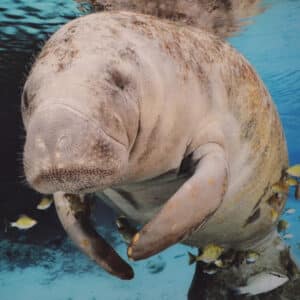
WEST AFRICAN MANATEE: The West African manatee (Trichechus senegalensis) lives off the coast of West Africa. It is similar in size and shape to the West Indian manatee but its nose is shorter and rounder. This type of manatee can be found in both freshwater and saltwater.
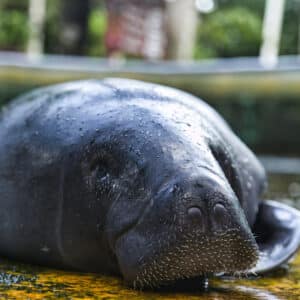
AMAZONIAN MANATEE: The Amazonian manatee (Trichechus inunguis) is the smallest of the manatee family. They usually grow to ~3 metres in length. You can only find them in the freshwater rivers of the Amazon River Basin and its tributaries.
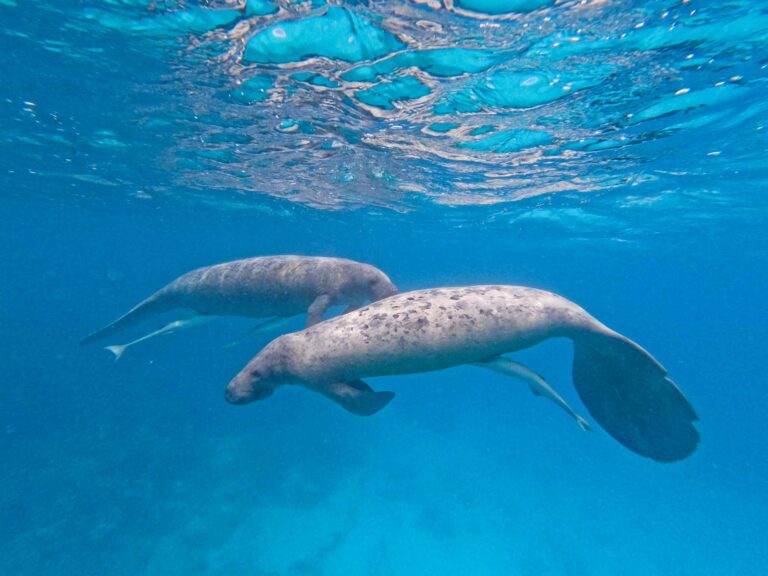
Two manatees swim together in Caye Caulker (yes, we took this photo!)
WHY SWIM WITH MANATEES IN BELIZE?
The Belize Barrier Reef (also known as the Mesoamerican Barrier Reef) stretches from Mexico to Honduras. It is the second largest barrier reef, after the Great Barrier Reef in Australia, and offers some of the most amazing snorkelling and diving in the world.
Belize has the most manatees of any country in Central America, so your chances of seeing one there in the wild are high. If you spot one, you can also swim with manatees in Belize! Swimming with manatees in Belize is a special chance to get close to these endangered animals and observe them in their natural habitat.
You’ll have the unique chance to see how they interact with each other – something they don’t do very often. You’ll also be able to see how they feed on plants and how they float gently up to the surface for a breath every few minutes.
Seeing a manatee is a rare and special thing, If you take a snorkel tour to swim with manatees in Belize, there’s not a 100% chance that you will see one. But if you’re lucky, you’ll be able to swim alongside these gentle blobs and experience how they interact with each other.
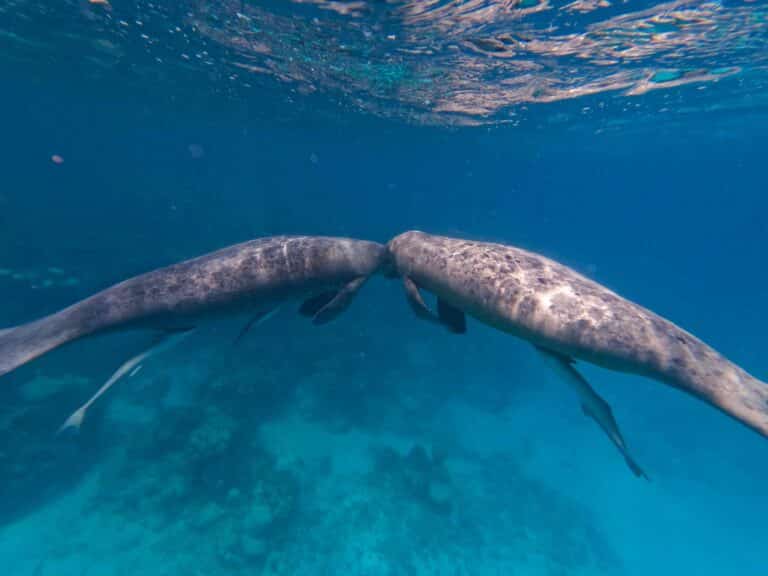
Manatees nuzzling each other in Caye Caulker on our snorkel trip
CONSERVATION CHALLENGES OF MANATEES IN BELIZE
But manatees face some challenges. Boat collisions, habitat hiccups, and illegal hunting are real issues. In 2008, the West Indian Manatee was declared an endangered species. The good news? Belizeans are on it!
Manatees are protected by law in Belize, and various conservation organisations are working hard to protect the manatees through habitat safeguards, public awareness campaigns, and teaming up with local communities.
There are now several wildlife sanctuaries in Belize, such as the Gales Point Manatee Wildlife Sanctuary, the Corozal Bay Wildlife Sanctuary, and the Swallow Caye Wildlife Sanctuary. Conservation efforts also often involve research, education, and the implementation of protective measures to reduce human impacts on manatee populations.
So, next time you’re in Belize, keep an eye out for these marine VIPs. Cruise responsibly, appreciate their beauty, and let’s ensure the Belizean manatees keep enjoying their tropical paradise for generations to come! 🌴💙
We hope that this guide helps you not only to plan your trip to snorkel with manatees in Belize, but also encourages you to be a responsible wildlife tourist whilst you’re there.
WHERE CAN YOU SEE MANATEES IN BELIZE?
There are several places where you can spot, and maybe even swim with manatees in Belize, depending on the season and the availability of tours. Some of the best spots are:
- Corozal Bay Wildlife Sanctuary in northern Belize. This is one of the most reliable places to see manatees in Belize! However, due to the risk of crocodiles, it’s not recommended to swim here.
- Swallow Caye Wildlife Sanctuary (near Belize City). Another protected area and almost guaranteed to see manatees here! You can take a boat tour from Belize City or Caye Caulker. But you can’t swim with them here either due to it being a protected area.
- Gales Point Manatee Wildlife Sanctuary: This is a remote and pristine part of Belize and a popular manatee feeding area! If you’re lucky, you may also see nesting turtles. We didn’t visit here and it’s unsure whether you can swim with manatees here.
- Caye Caulker: This isn’t the manatees’ favourite area and sightings are never 100% guaranteed. But, if you see a manatee whilst on a snorkel tour from Caye Caulker, you may be allowed to slowly enter the water and swim alongside it (respectfully of course!)
In this blog post, we’ll be talking about swimming with Manatees in Caye Caulker. This is the only place in Belize (that we could find at least) where you are allowed to be in the ocean near a manatee!
Reminder: There is never a 100% chance you will actually get the chance to swim with Manatees. As chill as these guys are, they can be pretty elusive. They may only pop up to the surface for a breath, before heading back under for up to five minutes. Once they’re back under the water, you won’t even know they’re there.

Manatees coming up for air in Caye Caulker on our snorkel trip
IS IT ETHICAL TO SWIM WITH MANATEES IN BELIZE?
Ahh, the big question and the one I was asking myself before, during, and after the snorkel trip. Is it ethical to swim with manatees in Belize?
TLDR: Swimming with manatees in Belize can be an ethical and responsible wildlife encounter but only if you choose the right tour operator and practice responsible tourism throughout your swim.
WHAT IS ETHICAL AND RESPONSIBLE WILDLIFE TOURISM?
Wildlife tourism needs to be ethical and sustainable. Ethical tourism is something of a buzzword these days. It basically means ‘thinking about the consequences of your actions as a tourist on the environment, local people and local economy’. In this situation, it means taking responsibility to protect the ocean and the manatees (and other marine wildlife) that you’re hoping to see.
Manatees are gentle and curious animals. But they can also be very shy, very sensitive, and very elusive. Manatees are also highly vulnerable to human activities, such as boat strikes, habitat loss, pollution, and hunting. All of these are things that we need to take into consideration when answering the question: is it ethical to swim with manatees in Belize?
SO, IS IT ETHICAL TO SWIM WITH MANATEES IN BELIZE?
Firstly, let’s talk about the manatees in Belize. When you go on a snorkelling tour to swim with manatees in Belize, there’s never a guarantee that you will see one.
This is actually a good thing! It means that the manatees are not fed by tour guides trying to guarantee that these chill little blobs hang around for their tourists. Unfortunately, this is not the case for Belize’s Nurse Sharks (more about that later on in the post!).
If you are lucky enough to encounter a manatee in the ocean and swim alongside it, your manatee will be 100% wild. They aren’t captive and are free to swim away if they want to.
Manatees are also very well respected in Belize. Guides will strictly enforce rules if you get the chance to swim with manatees in Belize. This basically boils down to keeping a respectful distance, and not trying to chase, pet, feed, or (and this might seem like common sense but believe me, some people don’t have any) ride on a manatee.
Belize also doesn’t suffer from overtourism in the same way that other popular manatee-spotting locations, like Mexico and Florida, do. Overtourism can be incredibly damaging to wildlife. Too many people shouting and splashing around in their habitat can push manatees, and other animals, away from their feeding and mating spots.
For example Mexico’s Riviera Maya, a popular whale shark and manatee-spotting location, saw 37 million tourists touch down in the first half of 2023. Whereas Belize – the whole of Belize – had less than half a million tourists in 2023. This is good, as it means that tourist numbers put significantly less pressure on the marine ecosystem and wildlife there.
We would say that, yes, swimming with manatees in Belize can be an ethical and responsible wildlife encounter. But only if you choose a manatee-friendly tour company and follow all rules for swimming with manatees in Belize!
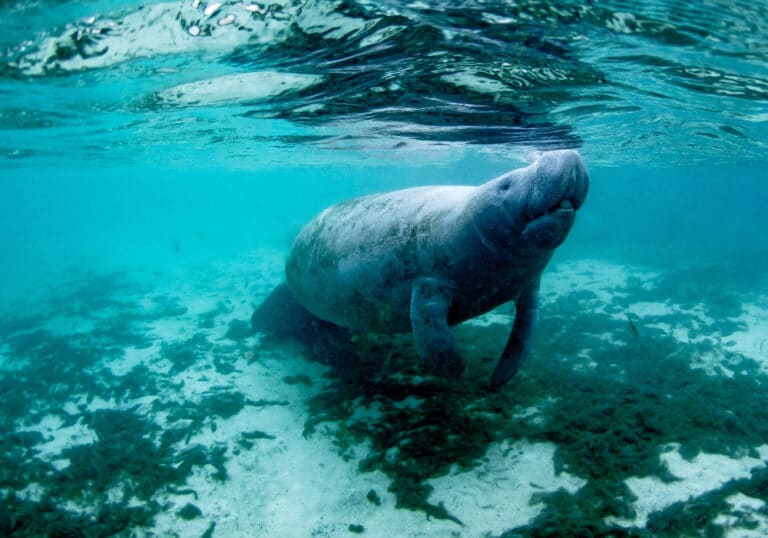
Manatees need to come up every five minutes for air
WHAT TO EXPECT ON A CAYE CAULKER SNORKEL TOUR?
Grab some breakfast and head to the tour office at your pre-arranged time. Here, you can settle any remaining payment. Your guide will hand out equipment, and show your group how to wear your snorkel and fins.
After that, you’ll head to the boat and set sail to the first snorkel location. Your guide should brief you on the snorkelling guidelines on the way. This includes; maintaining a respectful distance from any wildlife that you encounter, being aware of your fins, and not touching the corals. They may also provide more information about Belize, Caye Caulker and the reef that you’re heading to.
Then you’ll head to the following locations! Each tour company will visit these at different times so that all groups get a quieter and more intimate snorkelling experience – it wouldn’t make sense if everyone went to the same place at the same time.
#1 HOL CHAN MARINE RESERVE
Hol Chan Marine Reserve is around twelve miles away from Caye Caulker. It’s not far from Ambergris Caye, another island that’s a little more expensive and a little less backpacker-oriented. On entry, you’ll stop by the floating office, where you’ll be given a wristband as proof of your entry permit.
This marine reserve is one of the busier sites, as most tours stop here first to check in with the national park rangers. Hol Chan is where the reef drops off, which makes it a popular site for scuba diving and snorkelling. But don’t worry, there’s enough reef for everyone.
Check out our guide to scuba diving with sharks in Belize (coming soon)
Your guide will jump in with you and lead the group on a snorkel tour. There’s an abundance of marine life here, including sea turtles, lobsters, eels, sting rays and huge spotted eagle rays! There are also some amazing corals and so many colourful fish. However, you are unlikely to see manatees at Hol Chan.
#2 SHARK RAY ALLEY
Shark Ray Alley is another area that also belongs in the Hol Chan Marine Reserve, so keep hold of your wristband! And i’m not kidding when I say that you’ll be totally surrounded by nurse sharks. This shallow, sandy snorkel spot is a good opportunity to get close to these gentle bottom feeders. Don’t worry, they may be sharks but they aren’t dangerous.
Nurse sharks are big ocean puppies! They’re usually calm and non-aggressive and pose minimal risk to humans (most sharks don’t bite unless threatened). However, like any wild animal, they should be treated with respect and caution. Any animal may lash out if provoked, so it’s important to maintain a good distance and not try to touch them.
Before Caye Caulker became a backpacker island paradise, it was a small fishing village. The feeding of nurse sharks started in the 1980s when fishermen would clean their catch in the area and throw the scraps overboard. This easy meal attracted a ton of nurse sharks, who got used to the free food and began to associate the sound of engines with an easy meal
Reminder: There is never a 100% chance you will actually get the chance to swim with Manatees. As chill as these guys are, they can be pretty elusive. They may only pop up to the surface for a breath, before heading back under for up to five minutes. Once they’re back under the water, you won’t even know they’re there.
#3 CORAL GARDENS
Coral Gardens is another gorgeous spot to snorkel. Living up to its name, this site has excellent corals and lots of small but extremely colourful fish. There were also fewer snorkellers here than in other spots, so it was a nice, calm swim.
Keep an eye out here for rays and turtles! You might see manatees here, but as with nature, nothing can be guaranteed.
#4 CONCH SHELL GRAVEYARD
This is another area is where fishermen used to dump their catch. After they removed the meat, they dumped the empty conch shells here. Seriously, the sea bed is covered in conch shells with their beautiful pink colour inside.
As a result, lots of wildlife visits the area, particularly turtles and stingrays. It can get quite shallow in some areas, so you can see them up close! We saw some huge stingrays here. They were majestic.
#5 BELIZEAN TITANIC
Ok, it’s not quite the titanic, but it’s still fun to explore! This sunken barge provides a structure for many different coral species and creates lots of little hidey-holes for fish to make their home. We also saw a turtle here!
The ship itself is relatively shallow, so you can see it from the surface. If you can hold your breath, you can dive down to get a closer look. There are several openings in the ship for more advanced snorkellers to check out the inside!
#6 MANATEE STOPS (& OTHER COOL STUFF)
In addition to the five ‘main’ stops, your boat will also stop when your guide sees anything interesting. This may include manatees, turtles or dolphins. Our boat made three unexpected stops, two for manatees and one for a huge turtle!
There is no designated spot on the snorkel tour to see manatees in Belize as they move around grazing. However, there are spots where they may be seen more often, and your snorkel tour will drive past these to check if there are any sea blobs hanging around.
Salt Life Eco Tours set off early to take us to one popular manatee grazing spot. We saw one but it was already swimming away (they can be pretty shy!). I’d given up hope, but as we were heading back to the island, we saw a manatee coming up for air! The boat stopped and we jumped in to observe the gentle sea blobs.
#7 TARPON STOP
Tarpons are huge, silvery, prehistoric-looking fish (seriously, they’re massive!). You can find them around Caye Caulker, and your tour will usually stop where they hang out. If you hold your hand above the water, sometimes they’ll jump out!
Top tip: Don’t feed the tarpons even if they are renowned for jumping out of the water to eat from your hand. We should all work together to keep wildlife wild and not make them dependent on humans for food.
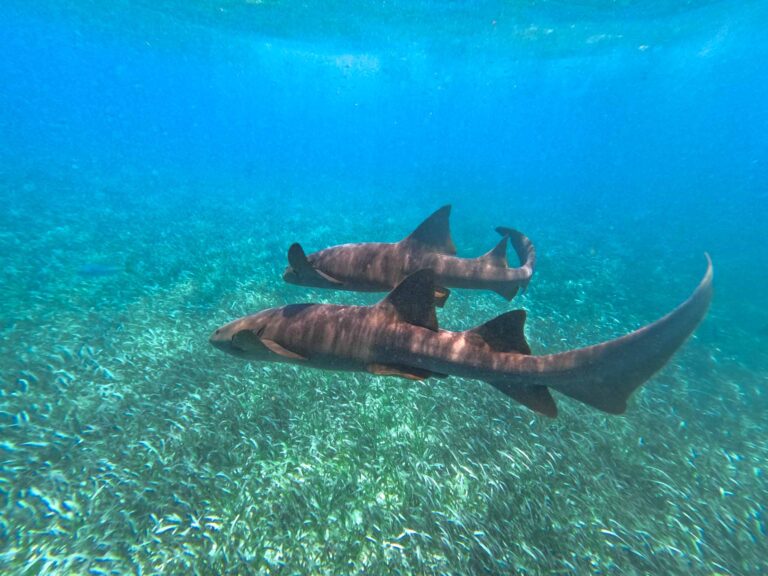
Nurse sharks in Belize! These aren’t dangerous at all.
IS SNORKELLING WITH MANATEES IN BELIZE DANGEROUS?
Sharks? Stingrays? You might be wondering: is it safe to swim with manatees in Belize?
None of the animals you swim with are dangerous to humans (yes, that includes nurse sharks!). We are more dangerous to them. That’s why it’s so important to join a tour that has a focus on responsible and ethical wildlife tourism and to follow all guidelines.
When you go snorkelling, you can wear a life jacket and you’re free to get back onto the boat whenever you feel tired. Of course, wildlife can be unpredictable and wild! Your guide will be in the water with you at all times, reminding you to keep a safe distance from any animals you encounter.
Honestly, the biggest risk when snorkelling is probably jellyfish stings. Jellies float along, oblivious to the world around them, so keep an eye out! If you’re worried about being stung, wear a long-sleeved rash guard and leggings. You can also get ‘burned’ by fire coral, but you shouldn’t be touching the corals anyway, so if you get stung it’s your own fault.
HOW TO BOOK A MANATEE SNORKELLING TOUR IN CAYE CAULKER?
WHICH TOUR COMPANY SHOULD I CHOOSE TO SWIM WITH MANATEES IN BELIZE?
There are so many snorkel tour operators in Caye Caulker. Just take a stroll down the main street and see so many different offices advertising the chance to swim with manatees in Belize.
After walking up and down for a couple of days, we chose Salt Life Eco Tours. This is because they were one of the only companies advertising that they were practising responsible tourism. Salt Life Eco Tours genuinely seemed passionate about the marine environment and protecting the reef and the wildlife that call this area home.
We were really impressed by how strictly the guides enforced guidelines for ethical and responsible tourism. There was no touching of coral, sharks, rays and fish permitted on the tour and no feeding of any of the marine life (this includes the sharks, stingrays and tarpon). If anyone got too close to an animal, our guide would gently tell them off.
We also saw that Ragamuffin Tours are another company that prioritises ethical wildlife tourism but can’t speak about them personally. As usual, do your research and make an educated decision for yourself.
Top tip: Choose the right tour! The only way that you should swim with manatees in Belize is to book a tour with a reputable and experienced operator that follows the best practices for responsible tourism.
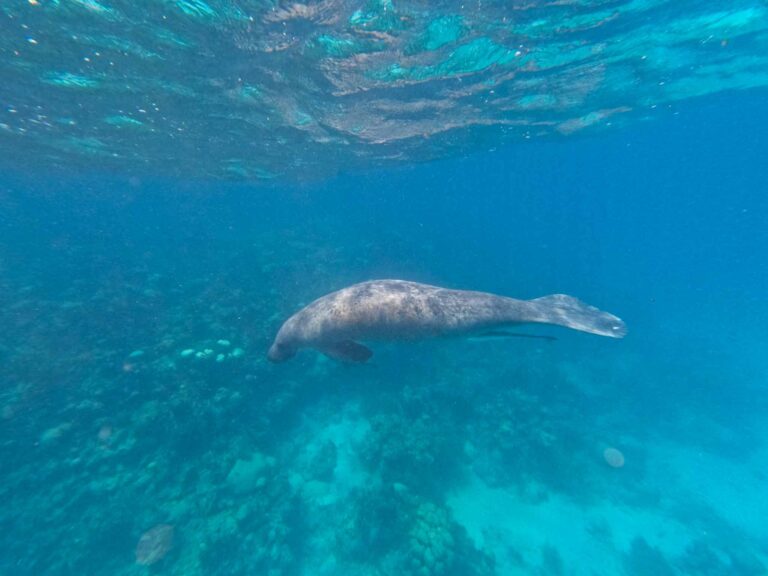
A manatee chases fish in Caye Caulker
WHICH TOUR OPTION SHOULD I CHOOSE TO SWIM WITH MANATEES IN BELIZE?
There are four different tour types to see manatees in Belize:
- Full-day snorkelling Tour
- Half-day snorkelling Tour
- Multi-day tour
- Scuba Diving Tour
A detailed comparison of the itinerary options is below but TDLR; we chose to do the Full-Day Itinerary. We also went on a Scuba diving tour the next day, but not with a specific aim to swim with manatees!
FULL-DAY SNORKEL TOUR:
A full-day snorkelling tour from Caye Caulker typically lasts from 10:30am until 4:30pm. Caye Caulker is a small island, and there’s not tons to do there except dive, snorkel, and relax. This means that a full-day snorkel tour doesn’t cause you to miss out on any island activities. You’ll still have the evening to relax and watch the sunset
The price of a full-day snorkelling tour is between $90 to $120 USD. Belize, in general, is pretty expensive compared to the rest of Central America. After doing our research, we thought that a full-day tour was the best value for money. I wanted to maximise our chances of swimming with manatees in Belize, and a full-day tour seemed to be the way to do this! .
On the full-day tour, you’ll visit 5 – 7 locations (see above!), plus extra stops if your guide sees something interesting. Each company uses slightly different names for the locations, but most tours will visit the same spots.
We went with Salt Life Eco Tours. They had 7 scheduled stops, plus a bonus stop when we saw Manatees! This full-day tour set off earlier than most tours so we could catch a glimpse of any wildlife before it got disturbed by all the boats. The tour included the park fee ($10 USD), snorkelling gear, fruit, lunch and water provided.
Top tip: choosing a tour that sets off a little earlier may mean that you can’t linger over your breakfast, but you’ll have a much higher chance of seeing manatees enjoying theirs! The best time to see manatees is in the morning, before the snorkel sites get too busy.
HALF-DAY SNORKEL TOUR:
The half-day snorkelling tour runs for 3 hours. You can go in the morning (10 am to 1 pm), or in the afternoon (2 pm to 5 pm). A half-day tour is half the price of a full-day tour costing between $45 and $60 USD.
You’ll visit three locations, including the Caye Caulker Marine Reserve, Shark Ray Alley, and the Coral Graveyard. You’ll also get your snorkelling gear, lunch, some fruit snacks, rum punch, and your park fees included.
Unless you are really short on time (and I’m talking only-one-day-in-Caye-Caulker-short) I don’t recommend this tour. All the locations on the full-day tour are extremely unique and Hol Chan Marine Reserve is a real highlight (we loved it so much that we actually went back to dive there the next day!)
If you want to swim with manatees in Belize, and see nurse sharks, coral reefs, turtles, and spotted eagle rays, the full day is a must to maximise your chances.
MULTI-DAY SNORKEL TOUR:
Many operators offer multi-day sailing tours around Belize’s Cayes. These don’t come cheap, but could be worth looking into if you’d like to get off the beaten track and visit remote snorkelling spots and islands.
More remote means more chances of seeing rare wildlife, so if you’re desperate to swim with manatees, this could be a tour for you!
SCUBA DIVING TOUR:
Belize has some of the best scuba diving in the Caribbean. If this is something you’d like to try, you can do your PADI Open Water and Advanced Open Water qualifications here.
Caye Caulker is also great for some fun dives. Our scuba diving tour visited Hol Chan Marine Reserve, and you can also dive in the famous Belize Blue Hole. This isn’t the best place to swim with manatees in Belize, but it’s still an un-Belizable experience and you’ll likely see a lot of other wildlife (my favourite was the Caribbean Reef Shark!).
Top tip: Belize is quite expensive compared to other Central American countries, so we’d recommend heading down the reef to the Bay Islands of Honduras if you want to dive a lot. It’s much cheaper, and the wildlife that you’ll encounter is similar.
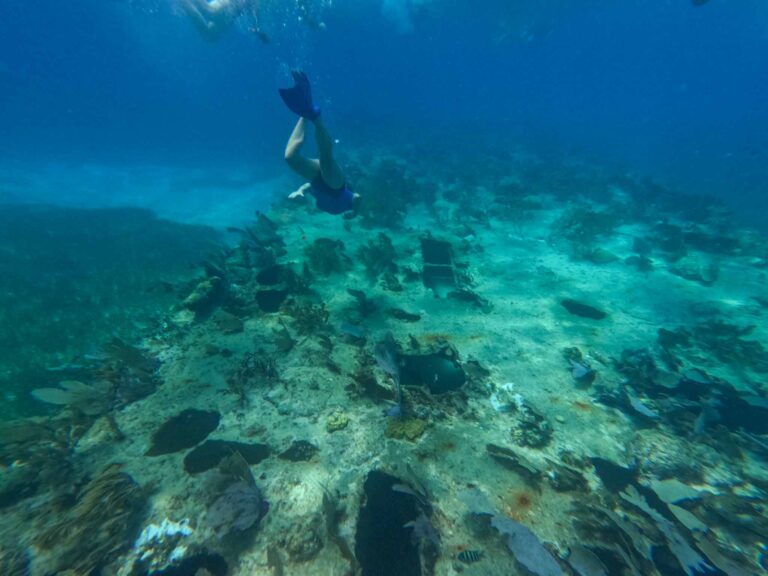
Exploring a ship wreck near Caye Caulker
RULES TO FOLLOW WHEN YOU SWIM WITH MANATEES IN BELIZE?
1.
Respect their space: You should always keep at least 5 metres away from the manatees and never try to touch them, chase them, or ride them (yep… there are people who would try that). Let them approach you if they are curious, but you’ll probably find that they’re not bothered.
2.
Be patient: The manatees in Belize are 100% wild, and have their own behaviour and personalities. They can be playful and friendly. They can also be shy and swim away. It can be annoying when you jump in only to see that you’ve scared a manatee away but try to be patient. Seeing these animals in their natural habitat is such a privilege.
3.
Don’t use camera flash: This applies to taking photos of any animal, whether that’s on land, in the ocean, or at a zoo/aquarium. Flash photography can disturb and scare away wildlife. So switch off the the flash on your phone before you pop it in its waterproof case, and make sure you know how to do it for any other equipment, such as your GoPro too.
4.
Avoid wearing sunscreen: Caring for your skin is important. But if you’re going to snorkel with manatees, you need to stay clear of the sunscreen or make sure you choose reef safe sunscreen that’s 100% biodegradable! Coral reefs are dying, species are disappearing at an alarming rate, and whilst this isn’t entirely down to your choice of sun protection, the chemicals in sunscreen are super hazardous to ocean wildlife. Wear a t-shirt instead!
You shouldn’t use any other oils or lotions either. Scientists say that environmental contaminants in your favourite skincare products might damage the manatees skin.
WHAT TO PACK WHEN YOU SWIM WITH MANATEES IN BELIZE?
Swimwear: You’re going swimming, so best pack your swimsuit! We also recommend wearing a long-sleeved t-shirt and leggings to protect yourself from the sun.
Snorkelling gear: masks, snorkels, fins, and (optional) life jackets will be provided by your tour company. Many of them offer prescription goggles for glasses-wearers. Of course, if you have your own gear, feel free to bring it!
Top tip: it sounds gross, but if you spit in your goggles and then rinse them afterwards, it’ll stop them from fogging up!
Towel: You won’t need to dry off, as you’ll be in and out of the water all day. But a towel or a shirt is great to cover your shoulders whilst on the boat and help you to avoid sunburn.
Camera or Phone: Swimming with manatees in Belize is a once-in-a-lifetime experience that you will definitely want to capture. Some companies email around GoPro footage after your tour, but feel free to bring your own! Make sure that any camera or phone is waterproof or has a waterproof case.
Water Bottle: Belize is hot and humid, and you’ll be out in the sun all day, so it’s really important to stay hydrated. You should drink plenty of water before, during, and after your tour. Keeping hydrated can also stop you getting sunburned so badly!
Snacks: Snorkelling can be exhausting and you will burn more calories than you think. Lunch is included, but if you think you’ll get hungry, pack a few snacks. I’m speaking from experience when I say things are more fun when you aren’t ‘hangry’.
Extra Cash: Most tour operators will include everything (transportation, equipment, guides, and lunch) in their price, but you may wish to leave a tip if you think they did a good job. Tips are appreciated but definitely not expected!
Dry bag: Important for keeping all the stuff I just mentioned dry!
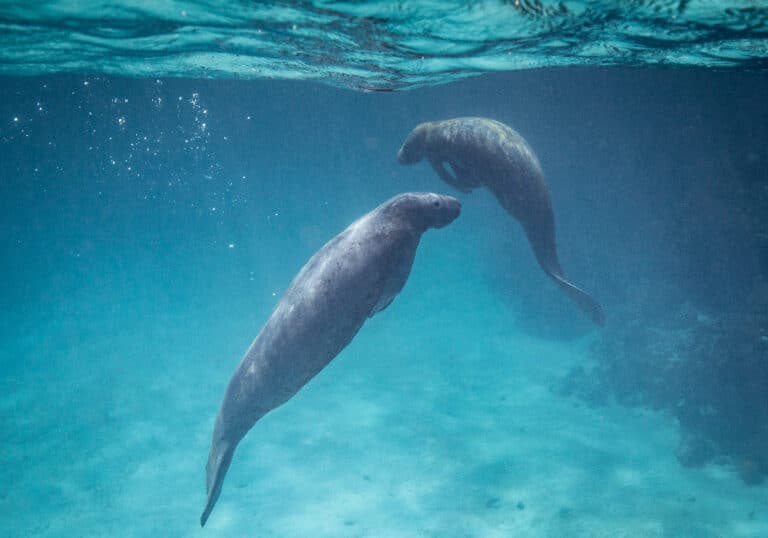
Two manatees in Caye Caulker on our snorkel trip
OTHER AMAZING THINGS TO DO IN CAYE CAULKER?
We loved Caye Caulker! This little island has such a different vibe from all the other Central American beachy locations – in the best possible way of course! Here are our favourite things to do in Caye Caulker.
#1 GO SCUBA DIVING WITH SHARKS
This was one of the craziest things that we did in Central America! If you like diving, Belize is an insanely cool destination. Hol Chan Marine Reserve is home to Caribbean Reef Sharks, which look scary, but will keep out of your way (if you keep out of theirs!). You’ll almost definitely see sharks on a scuba diving tour, as well as tons of fish, turtles, corals, and starfish.
#2 CHILL OUT AT THE LAZY LIZARD
The Lazy Lizard, on the tip of the southern island of Caye Caulker, is one of the coolest bars on the island. Grab an ice-cold beer or soda, kick back and watch the sunset from the Split. If it’s hot, you can dive off their pier and float around in the ocean. Watch out for stingrays!
Fun fact: Did you know that the islands of Caye Caulker used to be joined? Caye Caulker was one island until a hurricane ripped through and split it into two, creating what locals fondly called ‘The Split’.
#3 RELAX IN A BEACH HAMMOCK
Embrace Caye Caulker’s laid-back island life and relax in a beach hammock, close your eyes, and listen to the waves. If your hostel doesn’t have any hammocks, head down the main street, where you can pay a couple of dollars a day to use the hammocks of larger hotels. They’re just as good!
#4 GRAB AN ICED COFFEE AT ‘ICE ‘N BEANS’
Ice ‘n Beans is one of the best spots in Caye Caulker for good coffee, breakfast, and ocean views. The staff hand out free coffee shots and mini doughnuts whilst you wait, and you can spend the morning relaxing in a hammock or a beach chair. They also have amazing Wi-Fi connection, perfect for digital nomads who need to get some work done.
THINGS TO AVOID IN CAYE CAULKER
#5 FEED THE STINGRAYS AT IGUANA REEF INN
You’ll see a lot of travel bloggers recommending feeding the stingrays at Iguana Reef Inn. Every evening at 5 pm the hotel staff feed the stingrays from their private pier. They’ll encourage you to touch and hold the stingrays as they glide through the water and even feed them by hand.
This should be a big red flag! These stingrays are wild, but their behaviour is being changed by humans, for our entertainment. If you want to see stingrays, we recommend booking onto a snorkelling or diving tour. Or just go for a swim off one of Caye Caulker’s little beaches. These guys are literally everywhere. You don’t need to support unethical wildlife practises to see them.
We hope this guide has helped you to plan your trip to swim with manatees in Belize, and to do it ethically and responsibly. If you have any more questions about swimming with manatees in Belize, feel free to drop us a message on Instagram or leave a comment here and we’ll get back to you!

We loved Caye Caulker!
If my content helped you plan your next adventure, taught you something new, or simply made you smile, consider supporting the site! A small donation helps keep this blog going, fuels my creativity, and maybe even buys me a coffee along the way. Thank you for being here and being part of this journey! 😊
FAQs
CAN I SWIM WITH MANATEES IN BELIZE?
Yes you can! This blog post will tell you how to swim with manatees in Belize, so scroll up to the top and start reading
WHERE IS THE BEST PLACE TO SWIM WITH MANATEES IN BELIZE?
Although manatees are never guaranteed, the best place to swim with manatees in Belize is by booking a snorkelling tour in Caye Caulker. Even if you don’t see manatees, you’ll still have an awesome time!
WHERE CAN I SEE MANATEES IN BELIZE?
There are three protected areas that you can see manatees in Belize. These are Corozal Bay Wildlife Sanctuary, Swallow Caye Wildlife Sanctuary, and Gales Point Manatee Wildlife Sanctuary. You are almost guaranteed to see manatees year-round in any of these places!
WHEN ARE MANATEES IN BELIZE?
Manatees can be seen in Belize year-round, but particularly during the mating season from March to September.
WHAT TIME OF DAY ARE MANATEES MOST ACTIVE?
The best time to see manatees in Belize is in the morning before all the tour groups go out. Manatees can be shy and elusive and may avoid large groups of boats or people.
CAN YOU SNORKEL WITH MANATEES FROM CAYE CAULKER?
Yes! The snorkelling around Caye Caulker is some of the best in the world. You can hire snorkel masks and fins for a budget-friendly self-led tour around the island, where you’ll likely see fish, stingrays, and turtles. Or, you can book a snorkelling tour if you want to go out to the coral reefs for a higher chance of encountering sharks, turtles, stingrays and maybe manatees or dolphins.
LIKE IT? PIN IT!
SAVE THIS TO YOUR BELIZE TRAVEL BOARD TO INSPIRE YOUR NEXT TRIP
Disclaimer: The information and advice provided in this blog are the author’s opinions and based on their personal experiences. All information was accurate at the time of writing. However, things can change quickly, so always double-check current conditions and guidelines before setting out. Remember, your travels and safety are your own responsibility, and this blog can not be held responsible for anything that might happen on your adventures! Always exercise caution and good judgment. Oh, and don’t forget to get travel insurance! Happy travels!
This post may contain affiliate links (yay for transparency!) This means that I will earn a small commission, at no additional cost to you, if you click the link and choose to buy the product. I only link to stuff I have personally bought and found useful and never endorse crap. Your support helps keep the site going, thank you!
Alice
Alice is a UK travel blogger who advocates sustainable travel and being more eco-conscious on a budget. She loves coffee, her houseplants and summiting mountains.
You May Also Like
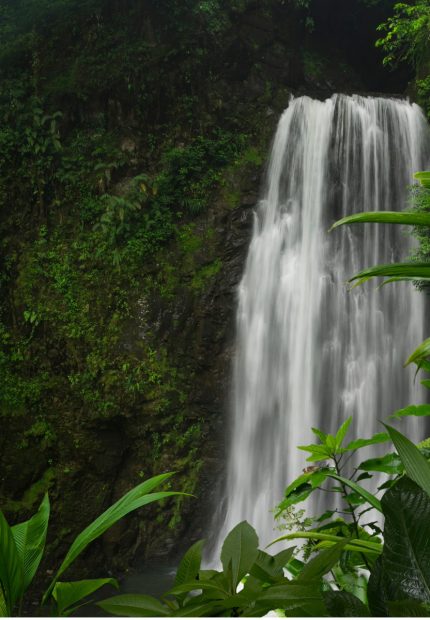
10 reasons to visit Central America during the rainy season
September 21, 2024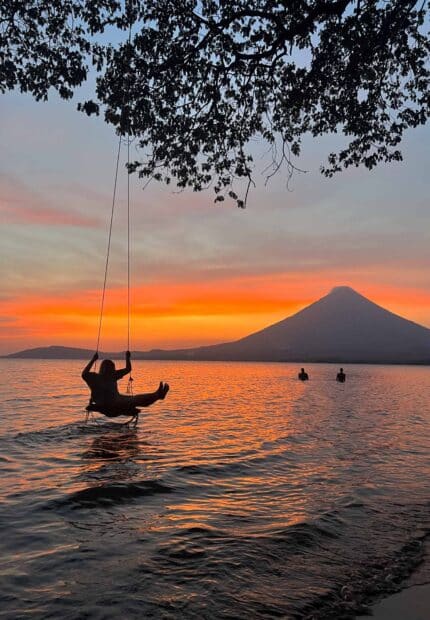
Do I Need to Speak Spanish to Travel in Central America?
April 13, 2024